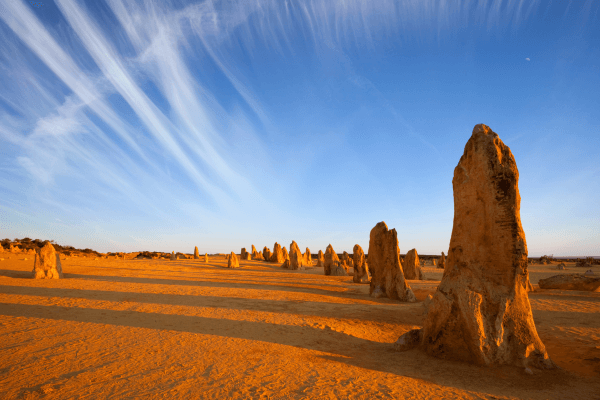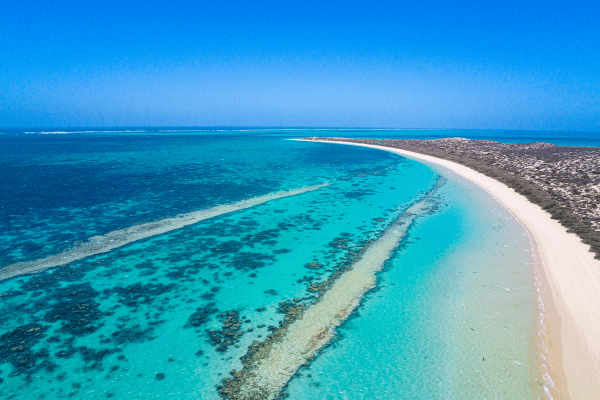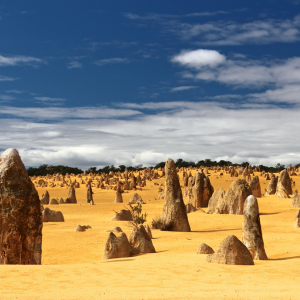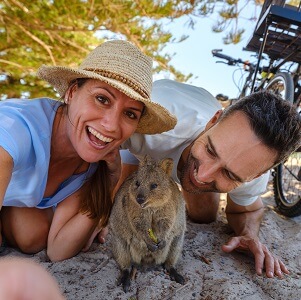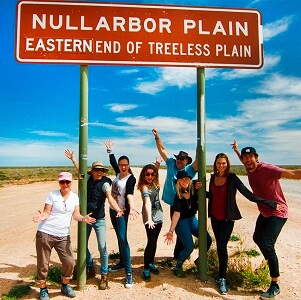The Pinnacles are fascinating limestone structures and are another unbelievable Australian natural wonder.
- The Pinnacles are fascinating limestone structures and are another unbelievable Australian natural wonder.
- About the Pinnacles
- The Pinnacles’ connection to the Aboriginal people
- How can I see the Pinnacles?
- How the Pinnacles formed
- What to do in and around the Pinnacles
- Explore all of the Pinnacles Tours from Perth
These limestone formations are in the sprawling expanse of the Nambung National Park in Western Australia. They form an eerie silhouette on a desert inspired backdrop and date back thousands of years.
Around the area, keep an eye out for the western grey kangaroos as they tuck into the sparse vegetation just after the sun rises. You might be able to spot Baudin’s black cockatoos and emus, as well as reptiles like bobtails, sand goannas, and carpet pythons.
About the Pinnacles
It’s believed the amazing natural limestone structures were formed around 25,000 to 30,000 years ago. The Pinnacles stretch up as high as five metres, scattered about randomly in the dry desert landscape. The raw material of the limestone stacks is said to form seashells, which give evidence of how old these structures truly are.
The Pinnacles’ connection to the Aboriginal people
These Pinnacles and their surroundings are a significant region for the traditional owners of the land, the Noongar people. The Pinnacles are sacred to the Noongar people, both spiritual and practical.
During the wet season, the Nambung River made a chain of waterholes throughout the park, with the water flowing into the cave systems. These cave waterholes became essential in the survival of the tribe for hundreds of years.
The Pinnacles are significant for the Noongar women. Many women groups gather together in the desert to do traditional ceremonies, give birth, and camp beneath the stars.
How can I see the Pinnacles?
You can either walk or drive around the trails to see the ancient Pinnacles. You only really need around half an hour, but most people spend an hour or two hours to take some photos and enjoy the overall scenery.
The coastal location of the Pinnacles means there are plenty of white beaches with crystal clear waters. The water is perfect for swimming, surfing, and snorkelling.
How the Pinnacles formed
There are quite a few theories detailing the formation of these natural structures. As these limestone creations are so unique scientists cannot narrow down the exact reason for their development. With three main theories detailing their formation.
• 1. Due to karstification
The formation was due to the karstification, which is the dissolution of the Tamala Limestone fragments. Weather caused solution pipes which over time progressed in size, resulting in the geography of the pinnacles.
• 2. Tree casts buried in the ground
This theory suggests the formation was due to the tree casts that were buried beneath the ground. The roots would breach through the soil into the calcrete. After the plants die, they leave an embedded crack in the soil. The climate in Western Australia altered, making the area a warm and dry climate.
The wind swept up the loose sand, creating a gradual deflation at ground level. The root cracks breached in the caliche capping remains. This resulted in the caliche capped material reaching the surface and becoming the Pinnacles.
• 3. A mass flow by plants
The third theory suggests that the Pinnacles were created by plants. Due to the water, minerals, and nutrients being drawn by the plant’s roots, it caused a mass flow surrounding the roots. Calcium was one of these nutrients, and over time caused the formation of calcrete.
When the plants died, climate and weather caused deflation in the ground. The reaming calcrete then created the Pinnacles.
What to do in and around the Pinnacles
• Fishing
For keen fishermen, Thirsty Point Lookout in Cervantes is the best spot to go to catch a fish or two. The town also provides amazing beaches to go swimming or snorkelling.
Keep your eyes peeled for sea lions and bottle-nosed dolphins if you choose to delve into the underwater world.
• Snorkel or kayak at Ningaloo Reef
Ningaloo Reef is a beautiful reef where you can discover all kinds of incredible fish and other colourful sea creatures. The reef is also world famous as one of the favourite congregation spots of the mighty whale shark, not to mention incredible humpback whales and manta rays.
The best part about Ningaloo Reef is you can swim alongside these sea creatures, taking in the beauty and serenity of the sea floor below.
Or you can take part in a kayak half-day or full-day tour. These small group eco-tours take you to explore this incredible UNESCO World Heritage-listed site.
• Explore Cape Range National Park
Directly by the coast of Ningaloo Reef is Cape Range National Park. Traverse rugged canyons and deep gorges as you take in the sublime flora. Keep an eye out for Aussie animals like kangaroos, emus and heaps of bird species.
Make sure you visit the beauty of the Pinnacles and book a one-day tour to see the limestone structures!
Explore all of the Pinnacles Tours from Perth
-
1 Day Pinnacles Tour
Destination: Perth
Duration: 1 Day
Tour type: Day Tour
Currently Unavailable
From $145
-
Pinnacles Day Tour from Perth
Destination: Perth
Duration: 1 Day
Tour type: Day Tour
Available Now
From $170
-
10 Day Adelaide to Perth Tour
Destination: Adelaide
Duration: 10 Days
Tour type: Overland Tour
Available Now
From $2495


